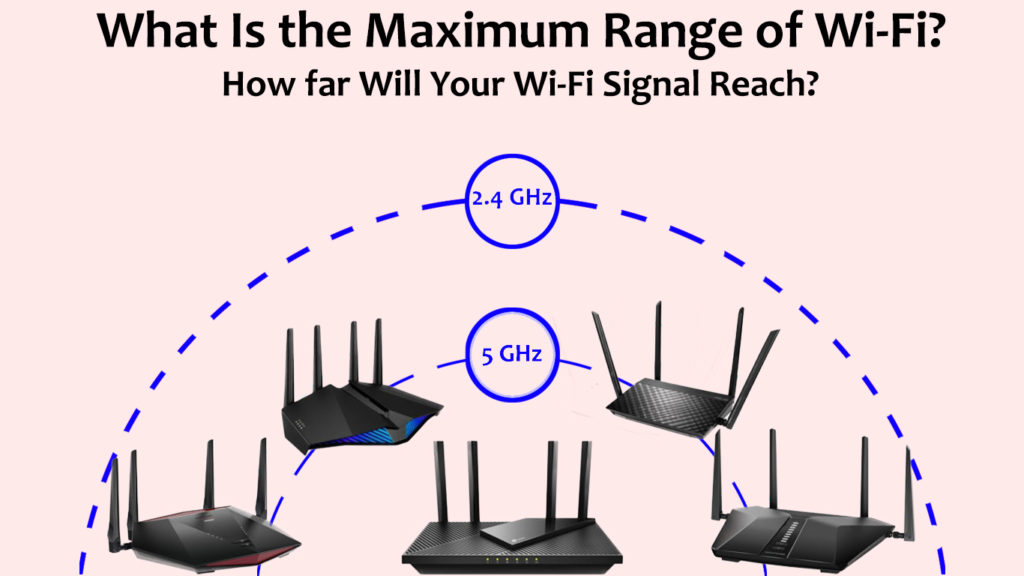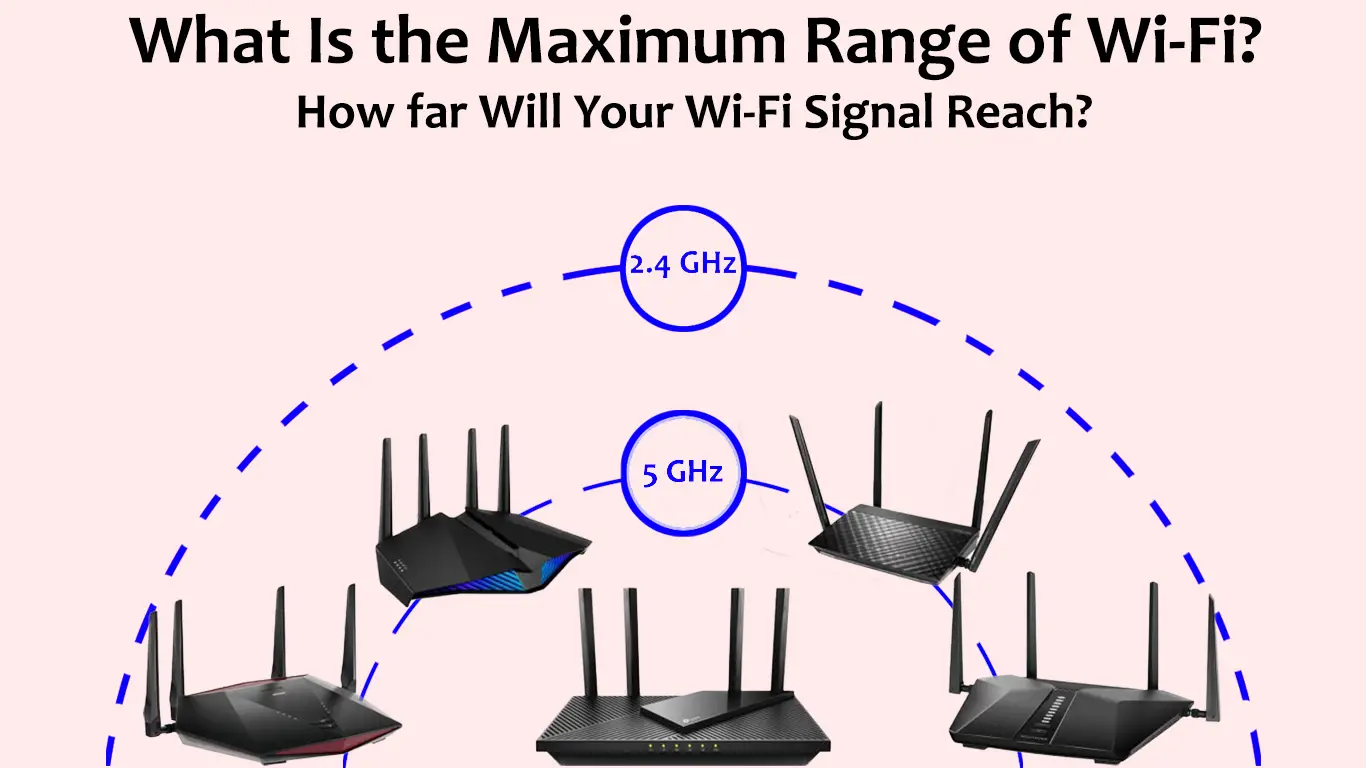The functioning of a man in today’s modern age without the use of Wi-Fi would be almost unthinkable. Only 10-15 years ago, we all used a wired connection (or had no connection at all) and only one computer to surf the internet. Today, when smart devices are all around us, Wi-Fi definitely plays a major role when talking about the internet.
One of the most important things about Wi-Fi is its range. The maximum range of Wi-Fi is especially important if you live in a large house or use it in a business space.
So, do you know the maximum Wi-Fi range? If the answer is no, read this article, and you will find the answer. In addition, you will learn other useful things related to the Wi-Fi range.

CONTENTS
Factors Affecting the Maximum Wi-Fi Range
The main factors that affect Wi-Fi range are the following:
- A version of the 802.11 standard that your device supports.
- Router model and transmitter power.
- Obstacles (room configuration) and other wireless devices that may interfere with the Wi-Fi signal.
Depending on the specific 802.11 protocol (WLAN standard) that your router supports, the maximum Wi-Fi range will be different. 802.11 is a WLAN standard created in 1997. Over the years, new versions were released. Its latest version is 802.11ax, which runs on dual-band wireless technology and supports simultaneous connections on two bands – 2.4 GHz and 5 GHz.
The maximum Wi-Fi range may vary. It depends primarily on the model of the router or wireless access point you are using.
A quality router is one of the main prerequisites for a good range of your Wi-Fi network. You should know that even though you may have bought an expensive router a few years ago, it may no longer meet the required standard.
Recommended reading:
- What is Fon Wi-Fi? (Everything You Need to Know About Fon Wi-Fi)
- What is Pocket Wi-Fi? (How Does It Work and How to Use It?)
- What is Wi-Fi 6? (Wi-Fi 6 Wireless Standard Explained)
- What is Wi-Fi 5? (Wi-Fi 5 Wireless Standard Explained)
- What is Wi-Fi 4? (Wi-Fi 4 Wireless Standard Explained)
A very positive thing about routers is that today you really have a great number of routers that meet the latest 802.11ac and 802.11ax standards. The prices are also much lower than they used to be a few years ago.
If you want your router to reach its full potential, it is necessary to update it regularly – this will also have a very positive impact on the security of your network.
The orientation of the antenna can also affect the maximum range of your Wi-Fi. You can test this yourself by monitoring the strength of the Wi-Fi signal on your smartphone as you rotate the antenna. You will see that the signal is stronger in the direction the antenna is facing, while it’s weaker in the opposite direction.
Keep in mind that physical barriers, such as walls, can reduce Wi-Fi range to some extent.
It may not have occurred to you, but other electrical devices can interfere with the Wi-Fi signal (more precisely, radio signals emitted by those electrical devices). For example, a microwave oven is one of the devices that can most often interfere with the Wi-Fi signal and reduce its maximum range.
Wi-Fi Interference Explained
In most cases, one household (house/apartment) uses only one router, which should not be a problem to ensure the proper functioning of your Wi-Fi.
With large office buildings, the situation is different because more access points are needed to successfully cover a larger area. It is worth mentioning that, in some cities, there are access points all over the city to provide Wi-Fi internet on a large scale.
What is the Maximum Wi-Fi Range?
As mentioned in the previous section, although the Wi-Fi range depends on several factors, the general rule is that in home networking conditions, Wi-Fi routers operating on a 2.4 GHz band can reach a maximum of 150 feet or 46 meters indoors, while in the open the maximum range is 300 feet or 92 m. Routers operating on a 5 GHz band will deliver much higher speeds, but their range will be significantly shorter.
What is the Best Location for a Router?
Choosing the right location for your Wi-Fi router has a huge impact on the functioning of the Wi-Fi signal and its maximum range.
Choose the central part of the apartment or house – that way you should have a uniform signal strength across your home.
Avoid places such as closed shelves or cabinets – place it in an open place with as few obstacles as possible.
Router Placement Guide – Finding the Best Place for Your Wi-Fi Router
Of course, it is clear to you that when we talk about the maximum range of Wi-Fi, the dimensions of your home – certainly affect it. If you live in an apartment that is not too big, you do not have to worry about the range. Even an average Wi-Fi router should be able to deliver a strong signal to each part of your home.
If you, on the other hand, live in a big house, a strong signal will cover a certain part of the house, but not the entire place. There could even be some spots without Wi-Fi coverage (the so-called dead spots). If that’s your case, you don’t have to worry too much because there is an easy solution.
What is a Wi-Fi Extender?
A Wi-Fi extender is a device that amplifies the Wi-Fi signal coming from the router and extends its maximum range. It is best to place it halfway between the router and places where there’s no Wi-Fi coverage (dead spots). It works by picking up a signal from your router and then retransmitting it
Wi-Fi Range Extenders Explained
Some of the very popular extenders, such as the most powerful model from NETGEAR, can extend the range of your Wi-Fi signal up to 2,500 feet.
Conclusion
Wi-Fi has become an integral part of our lives, and we all know how frustrating it can be if there is any problem with Wi-Fi speeds or Wi-Fi range. Hopefully, our article helped you understand what the max range of your Wi-Fi is (or could be if you find the right place for it). Try some of the tips explained in this article, and see if your Wi-Fi range improves.

Hey, I’m Jeremy Clifford. I hold a bachelor’s degree in information systems, and I’m a certified network specialist. I worked for several internet providers in LA, San Francisco, Sacramento, and Seattle over the past 21 years.
I worked as a customer service operator, field technician, network engineer, and network specialist. During my career in networking, I’ve come across numerous modems, gateways, routers, and other networking hardware. I’ve installed network equipment, fixed it, designed and administrated networks, etc.
Networking is my passion, and I’m eager to share everything I know with you. On this website, you can read my modem and router reviews, as well as various how-to guides designed to help you solve your network problems. I want to liberate you from the fear that most users feel when they have to deal with modem and router settings.
My favorite free-time activities are gaming, movie-watching, and cooking. I also enjoy fishing, although I’m not good at it. What I’m good at is annoying David when we are fishing together. Apparently, you’re not supposed to talk or laugh while fishing – it scares the fishes.

